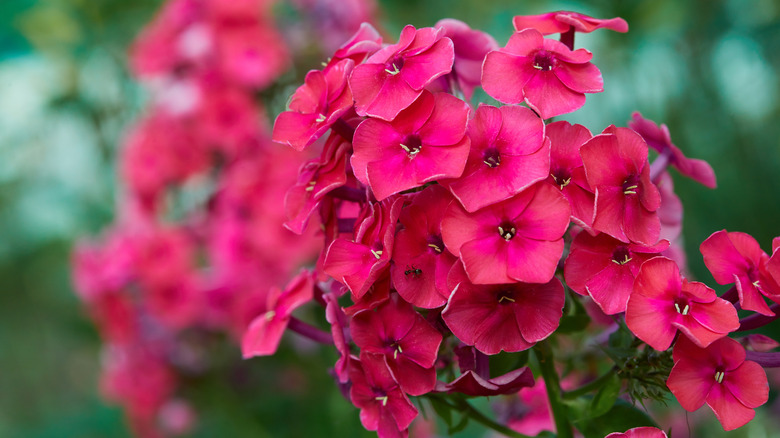The Unconventional Way You Can Plant Garden Phlox To Attract More Hummingbirds
There are many ways to entice hummingbirds to visit your garden. You can purchase a hummingbird feeder or even make a DIY the perfect one from your recycling bin. Adding hummingbird-friendly plants is always a good idea for bringing these fierce fliers to your outdoor space. To make your yard appealing to more hummingbirds, it's ideal to offer multiple food sources. Spread feeders and plants around your yard to give these lovely creatures more spots to eat without competition.
One great plant to draw in hummingbirds is through tall garden phlox (Phlox paniculata). While it's usually grown in the ground, you can also add it to hanging planters for a gorgeous display that attracts hummingbirds. Don't confuse this flower for growing a creeping phlox plant. While creeping phlox is a beautiful ground cover, tall garden phlox has an upright growth habit that reaches 30 to 40 inches, depending on the variety. For hanging plants, look for the most compact cultivars like 'Starfire,' which features bright red flowers, or the lilac hue of the 'Franz Schubert' garden phlox.
Beautiful benefits of tall garden phlox
There are so many varieties of garden phlox that there is certainly one to match your landscaping color palette. Although this plant offers hues ranging from white to orange to purple, if your goal is to attract hummingbirds, red is your best bet. They can drink the nectar from any color of plant, but hummingbirds are most likely to visit red blooms because this color often indicates a high level of nectar. The pigments in the cones of their eyes are also better able to see red blooms than those of more muted colors. Still, if red isn't your style, hummingbirds can and will visit various colors of flowers, as will many other beneficial insects like bees and butterflies.
The bloom time of garden phlox varies depending on the variety and the region in which it is planted. Most types bloom in mid- to late summer when many other flowers begin to fade in the heat. These plants typically provide an available source of nectar for about two months, but once again, that depends on the variety.
Grow your own phlox in hanging baskets
One of the best things about tall garden phlox is that most varieties are hardy perennials in USDA Hardiness zones 3 through 8. So, even though you are growing it above ground in a planter, you shouldn't have to worry about cold damage to the roots over the winter. Since garden phlox is quite tall, you'll need to place it in an area where it has plenty of room to grow upwards. The stems might grow above the hook, but that just makes this arrangement more interesting — who wants to see the hanger when you're using hanging plant baskets for a beautiful flower display?
To get started, add a layer of high-quality garden soil to a hanging planter with good drainage. Then, remove your plant from the nursery pot and gently loosen the roots. Center the phlox in the planter, and add enough soil so the top of the root ball and soil level are about one inch below the top of the pot. Water your plant well, and fertilize it regularly throughout the growing season, according to the instructions on the package. Keep the soil consistently moist for the best display of summer blooms.


